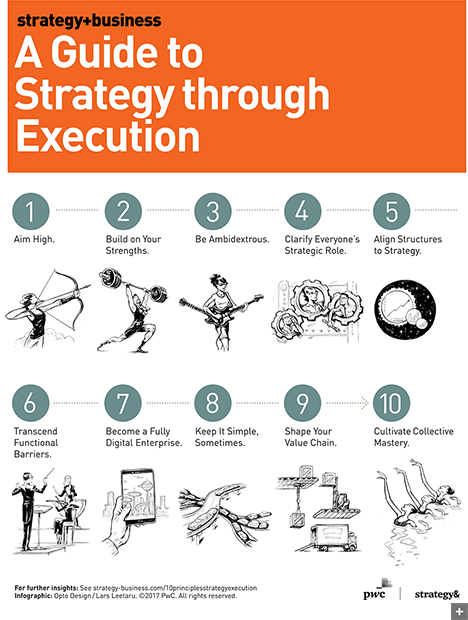10 Principles of Strategy through Execution
How to link where your company is headed with what it does best. See also “A Guide to Strategy through Execution.”
“We are all in the gutter,” wrote Oscar Wilde, “but some of us are looking at the stars.” That is the nature of strategy through execution. You operate deep in the weeds, managing countless day-to-day tasks and transactions. At the same time, you keep a steady gaze on your company’s long-term goals — and on ways you can stand out from your competitors.
Having a close link between strategy and execution is critically important. Your strategy is your promise to deliver value: the things you do for customers, now and in the future, that no other company can do as well. Your execution occurs in the thousands of decisions made each day by people at every level of your company.
Quality, innovation, profitability, and growth all depend on having strategy and execution fit together seamlessly. If they don’t fit — if you can’t deliberately align them in a coherent way — you risk operating at cross-purposes and losing your focus. This problem is all too common. In a recent Strategy& global survey, 700 business executives were asked to rate their company’s top leaders in terms of their skill at strategy creation and at execution. Only 8 percent were credited as being very effective at both.
Strategy&, the strategy consulting business of PwC, has been studying the relationship between strategy and execution for years. We have found that the most iconic enterprises — companies such as Apple, Amazon, Danaher, IKEA, Starbucks, and the Chinese appliance manufacturer Haier, all of which compete successfully time after time — are exceptionally coherent. They put forth a clear winning value proposition, backed up by distinctive capabilities, and apply this mix of strategy and execution to everything they do.
Any company can follow the same path as these successful firms, and an increasing number of companies are doing just that. If you join them, you will need to cultivate the ability to translate the strategic into the everyday. This means linking strategy and execution closely together by creating distinctive, complex capabilities that set your company apart, and applying them to every product and service in your portfolio. These capabilities combine all the elements of execution — technology, human skills, processes, and organizational structures — to deliver your company’s chosen value proposition.
How do you accomplish this on a day-to-day basis? How do you get the strategists and implementers in your company to work together effectively? These 10 principles, derived from our experience at Strategy&, can help you avoid common pitfalls and accelerate your progress. For companies that truly embrace strategy through execution, principles like these become a way of life.

1. Aim High
Don’t compromise your strategy or your execution. Set a lofty ambition for your strategy: not just financial success but sustained value creation, making a better world through your products, services, and presence. Apple’s early goal of making “a computer for the rest of us,” which effectively shaped the personal computer industry, is a classic example.
Next, aim just as high on the execution side, with a dedication to excellence that seems almost obsessive to outsiders. Apple, for instance, has long been known for its intensive interest in every aspect of product design and marketing, iterating endlessly until its notoriously demanding leaders are satisfied. The company’s leaders do not consider execution beneath them; it is part of what makes Apple special.
Together, a strong long-term strategy and a fierce commitment to excellent execution can transform not only a company, but a regional economy. After the 1992 Olympics in Barcelona, a group of local political and business leaders realized, with some disappointment, that the event hadn’t triggered the economic growth they had expected. So they resolved to change the region’s economy in other ways. Led by the mayor, the group created a common base of technologies and practices and set up training programs for local enterprises. By 2014, after two decades of persistent effort, the city had become a hub for research and technology companies. One legacy of the Olympics is a group of about 600 sports-related companies with a collective annual revenue of US$3 billion and 20,000 employees.
In carrying out this first principle, the top executives of your company must lead the way. They must learn to set lofty goals, establish a clear message about why those goals are relevant, and stick to them without compromise. This may take a while, because lofty goals require patience. You need to persevere without lowering your standards, and the confidence to believe you can reach the goals soon enough. Leaders must demonstrate that courage and commitment, or no one else will. At the same time, don’t be surprised if the rewards start to appear sooner than you expect — both financial rewards and the intrinsic pleasure of working with highly capable people on relevant projects. With high aspirations (for example, IKEA’s goal of “creating a better everyday life for the many people” or Amazon’s self-proclaimed role as the “everything store”), you recruit talented people who are deeply committed to being there. That’s one way you’ll know that you’re aiming high enough: The whole organization will start to feel like a better place to work.

2. Build on Your Strengths
Your company has capabilities that set it apart, things you do better than anyone else. You can use them as a starting point to create greater success. Yet more likely than not, your strongest capabilities have been obscured over the years. If, like most companies, you pursue opportunities that crop up without thinking much about whether you have the prowess needed to capture them, you can gradually lose sight of what you do best, or why customers respond to it.
Take an inventory of your most distinctive capabilities. Look for examples where you have excelled as a company, achieving greatly desired outcomes without heroic efforts. Articulate all the different things that had to happen to make these capabilities work, and figure out what it will take to build on your strengths, so that you can succeed the same way more consistently in the future.
Sometimes a particular episode will bring to light new ways of building on your strengths. That’s what happened at Bombardier Transportation, a division of a Canadian firm and one of the world’s largest manufacturers of railroad equipment. To win a highly competitive bid for supplying 66 passenger train cars to a British rail operator, Bombardier shifted its manufacturing and commercial models to a platform-based approach, which allowed it to use and reuse the same designs for several different types of railway cars. “Platforming,” which was a new operational strategy for the industry, required adjustments to Bombardier’s supplier relationships and product engineering practices. But the benefits were immediate: lower costs, less technology risk, faster time-to-market, and better reliability.
Bombardier won the bid — and, more importantly, learned from the experience, making the episode a model for other bids and contracts. When some Bombardier engineers complained about the platform approach on the grounds that it curtailed their creativity, the leadership had an immediate answer: The platform demonstrated capabilities that competitors couldn’t match and the company’s creativity could be focused on innovation. Additional contracts soon followed.
The more knowledge you have about your own capabilities, the more opportunities you’ll have to build on your strengths. So you should always be analyzing what you do best, gathering data about your practices, and conducting postmortems. In every case, there is something to learn — about your operations, and also about the choices you make and the value you’re able to deliver.

3. Be Ambidextrous
In the physical world, ambidexterity is the ability to use both hands with equal skill and versatility. In business, it’s the ability to manage strategy and execution with equal competence. In some companies, this is known as being “bilingual”: able to speak the language of the boardroom and the shop floor or software center with equal facility. Ambidextrous managers can think about the technical and operational details of a project in depth and then, without missing a beat, can consider its broader ramifications for the industry. If strategy through execution is to become a reality, people across the enterprise need to master ambidexterity.
Lack of ambidexterity can be a key factor in chronic problems. For instance, if IT professionals focus only on execution when they manage ERP upgrades or the adoption of new applications, they may be drawn to vendors for their low rates or expertise on specific platforms instead of their ability to design solutions that support the company’s business strategy. When the installation fails to deliver the capabilities that the company needs, there will be an unplanned revision; the costs will balloon accordingly, and the purchase won’t fulfill its promise.
We recognize, of course, that not everyone needs to be equally conversant in the company’s strategy. A typical paper goods manufacturer, for example, employs chemists who research hydrogen bonds to discover ways to make paper towels more absorbent. They may not need to spend much time debating strategy in the abstract, but they do need to be aware of how their role fits in. Like the apocryphal bricklayer who sees himself as building a cathedral, the highly skilled technologists on your team must recognize that they are not merely fulfilling a spec but rather developing a technology unlike anyone else’s, for the sake of building highly distinctive capabilities. They might even help figure out what those capabilities should be.
Similarly, your top leaders don’t have to be experts on hydrogen bonds or cloud-based SQL server hosting, but they do have to be conversant enough with technological and operational details to make the right high-level decisions. No longer can a senior executive credibly say, “I don’t use computers. My staff is my computer.” If your leaders aren’t ambidextrous, they risk being eclipsed or outperformed by someone who is.
In The Self-Made Billionaire Effect: How Extreme Producers Create Massive Value (Portfolio, 2014), John Sviokla and Mitch Cohen suggest using the word producers to describe ambidextrous individuals. Self-made billionaires, such as Spanx founder Sara Blakely, POM Wonderful cofounder Lynda Resnick, Uniqlo founder Tadashi Yanai, and Morningstar founder Joe Manseuto have this quality. They can both envision a blockbuster strategy and figure out in detail how to develop and sell it to customers. There are similarly ambidextrous people in every company, but they often go unappreciated. Find them, recognize and reward them, and give them opportunities to influence others.
Foster ambidexterity in practices and processes as well as in people. For example, in your annual budgeting exercises, ask people to explain the relationship of each line item to the company’s strategy, and specifically to the capability it is enabling. Over time, this approach will channel investments toward projects with a more strategic rationale.

4. Clarify Everyone’s Strategic Role
When the leaders of the General Authority of Civil Aviation (GACA) of Saudi Arabia decided to improve the way they ran the country’s 25 airports, they started with the hub in Riyadh, one of the largest airports in the country. They had already outsourced much of their activity, redesigning airport practices and enhancing operations. But not much had changed. Convening the directors and some department leaders, the head of the airport explained that some seemingly minor operational issues — long customs lines, slow boarding processes, and inadequate basic amenities — were not just problems in execution. They stood in the way of the country’s goal of becoming a commercial and logistics hub for Africa, Asia, and Europe. Individual airport employees, he added, could make a difference.
The head of the airport then conducted in-depth sessions with employees on breaking down silos and improving operations. In these sessions, he turned repeatedly to a common theme: Each minor operational improvement would affect the attractiveness of the country for commercial travel and logistics. A wake-up call for staff, the sessions marked a turning point for the airport’s operational success. Other airports in the Saudi system are now expected to follow suit.
The people in your day-to-day operations — wherever they are, and on whatever level — are continually called upon to make decisions on behalf of the enterprise. If they are not motivated to deliver the strategy, the strategy won’t reach the customers. It is well established that financial rewards and other tangible incentives will go only so far in motivating people. Workers cannot make a greater personal commitment unless they understand why their jobs make a difference, and why the company’s advancement will help their own advancement.
Successful leaders spend a great deal of time and attention on the connection between strategy and personal commitment. One such leader has run the trade promotion effectiveness (TPE) capability at two global consumer products goods (CPG) companies over the past several years. CPG companies use this capability to build the momentum of key brands. It involves assembling assortments of products to promote, merchandising them to retailers, arranging in-store displays and online promotions, adjusting prices and discounts to test demand, and assessing the results. A great TPE capability consistently attracts customers and compels them to seek out the same products for months after the campaign ends. TPE and related activities often represent the second-largest item (after the cost of goods sold) on the P&L statement. This in itself indicates the capability’s strategic importance for CPG companies.
In both enterprises, this executive took the time to go up and down the organization, making a case for why the specific mechanics of trade promotion matter to the value proposition of the company and, ultimately, to its survival. He made it a point to talk numbers but didn’t limit the conversation to them. “We spend billions at this company on promotions,” he might say. “We have to get back $100 million in added revenue next year, and another $100 million on top of that the year after.” He then urged employees to develop better promotions that would attract more consumers and increase their synergies with retailers. This combination of numbers and mission made it clear how people’s individual efforts could affect the company’s prospects.

5. Align Structures to Strategy
Set up all your organizational structures, including your hierarchical design, decision rights, incentives, and metrics, so they reinforce your company’s identity: your value proposition and critical capabilities. If the structures of your company don’t support your strategy, consider removing them or changing them wholesale. Otherwise, they will just get in your way.
Consider, for example, the metrics used to track the results delivered by call center employees. In many companies, these individuals must follow a script and check off that they’ve said everything on the list — even at the risk of irritating potential customers. Better instead to get employees to fully internalize the company’s strategy and grade them on their prowess at solving customer problems.
Danaher, a conglomerate of more than 25 companies specializing in environmental science, life sciences, dental technologies, and industrial manufacturing technologies, is intensely focused on creating value through operational excellence. Critical to this approach are metrics built into the Danaher Business System, the company’s intensive continuous improvement program. Only eight key metrics, called “core value drivers” to underline their strategic relevance, are tracked constantly in all Danaher enterprises. The financial metrics (core growth, operating margin expansion, working capital returns, and return on invested capital) are used not just by investors but also by managers to evaluate the value of their own activities. Danaher also tracks two customer-facing metrics (on-time delivery and quality as perceived by customers), and two metrics related to employees (retention rates and the percentage of managerial positions filled by internal candidates). Lengthy in-person operating reviews, conducted monthly, are very data driven, focusing on solving problems and improving current practices. The metrics are posted on the shop floor, where anyone can see the progress that’s being made — or not being made — toward clear targets. The meetings are constructive: People feel accountable and challenged, but also encouraged to rise to the challenges.
Data analytics is evolving to the point where it can help revitalize metrics and incentives. A spreadsheet is no longer enough to capture and analyze this body of material; you can use large information management systems programmed to deliver carefully crafted performance data. No matter how complex the input, the final incentives and metrics need to be simple enough to drive clear, consistent behavior. More generally, every structure in your organization should make your capabilities stronger, and focus them on delivering your strategic goals.

6. Transcend Functional Barriers
Great capabilities always transcend functional barriers. Consider Starbucks’ understanding of how to create the right ambience, Haier’s ability to rapidly manufacture home appliances to order, and Amazon’s aptitude for launching products and services enabled by new technologies. These companies all bring people from different functions to work together informally and creatively. Most companies have some experience with this. For example, any effective TPE capability brings together marketing, sales, design, finance, and analytics professionals, all working closely together and learning from one another. The stronger the cross-functional interplay and the more it is supported by the company’s culture, the more effective the promotion.
Unfortunately, many companies unintentionally diminish their capabilities by allowing functions to operate independently. It’s often easier for the functional leaders to focus on specialized excellence, on “doing my job better” rather than on “what we can accomplish together.” Pressed for time, executives delegate execution to IT, HR, or operational specialists, who are attuned to their areas of expertise but not necessarily to the company’s overall direction. Collaborative efforts bring together people who don’t understand each other or, worse, who pursue competing objectives and agendas. When their narrow priorities conflict, the teams end up stuck in cycles of internal competition. The bigger a company gets, the harder it becomes to resolve these problems.
You can break this cycle by putting together cross-functional teams to blueprint, build, and roll out capabilities. Appoint a single executive for each capability team, accountable for fully developing the capability. Ensure this person has credibility at all levels of the organization. Tap high-quality people from each function for this team, and give the leader the authority to set incentives for performance.
There’s always the risk that these cross-functional teams will be seen as skunkworks, separate from the rest of the enterprise. To guard against this risk, you need a strong dotted line from each team member back to the original function. Sooner or later, the capabilities orientation will probably become habitual, affecting the way people (including functional leaders) see their roles: not as gatekeepers of their expertise, but as contributors to a larger whole.

7. Become a Fully Digital Enterprise
The seventh principle should affect every technological investment you make — and with luck, it will prevent you from making some outdated ones. Embrace digital technology’s potential to transform your company: to create fundamentally new experiences and interactions for your customers, your employees, and every other constituent. Until you use technology this way, many of your IT investments will be wasted; you won’t realize their potential in forming powerful new capabilities.
Complete digitization will inevitably broaden your range of strategic options, enabling you to pursue products, services, and innovations that weren’t feasible before. For example, Under Armour began as a technologically enabled sports apparel company, specializing in microfiber-based synthetic fabrics that felt comfortable under all conditions. To keep its value proposition as an innovator, it aggressively expanded into fitness trackers and the development of smart apparel. The company is now developing clothing that will provide data that can both help athletes raise their game and point the way to design improvements.
Adopting digital technology may mean abandoning expensive legacy IT systems, perhaps more rapidly than you had planned. Customers and employees have come to expect the companies they deal with to be digitally sophisticated. They now take instant access, seamless interoperability, smartphone connectivity, and an intuitively obvious user experience for granted. To be sure, it is expensive and risky to shift digital systems wholesale, and therefore you need to be judicious; some companies are applying the Fit for Growth approach to IT, in which they reconsider every expense, investing more only in those that are directly linked to their most important capabilities. (See “Building Trust while Cutting Costs,” by Vinay Couto, Deniz Caglar, and John Plansky.)
Fortunately, cloud-based technologies provide many more options than were available before. To boost agility and reduce costs, you can outsource some tech activities, while keeping others that are distinctive to your business. You also can use embedded sensors and analytics to share data across your value chain and collaborate more productively (an approach known as “Industry 4.0” and the “Industrial Internet of Things”). The biggest constraint is no longer the cost and difficulty of implementation. It’s your ability to combine business strategy, user experience, and technological prowess in your own distinctive way.

8. Keep It Simple, Sometimes
Many company leaders wish for more simplicity: just a few products, a clear and simple value chain, and not too many projects on the schedule. Unfortunately, it rarely works out that way. In a large, mainstream company, execution is by nature complex. Capabilities are multifaceted. Different customers want different things. Internal groups design new products or processes without consulting one another. Mergers and acquisitions add entirely new ways of doing things. Although you might clean house every so often, incoherence and complexity creep back in, along with the associated costs and bureaucracy.
Many company leaders wish for more simplicity. Unfortunately, it rarely works out that way.
The answer is to constantly seek simplicity, but in a selective way. Don’t take a machete to your product lineup or org chart. Remember that not all complexity is alike. One advantage of aligning your strategy with your capabilities is that it helps you see your operations more clearly. You can distinguish the complexity that truly adds value (for example, a supply chain tailored to your most important customers) from the complexity that gets in your way (for example, a plethora of suppliers when only one or two are needed).
As Vinay Couto, Deniz Caglar, and John Plansky explain in Fit for Growth: A Guide to Strategic Cost Cutting, Restructuring, and Renewal (Wiley, 2017), effective cost management depends on the ability to ruthlessly cut the investments that don’t drive value. Customer-facing activities can be among the worst offenders. Some customers need more tailored offerings or elaborate processes, but many do not.
For example, Lenovo, a leading computer hardware company with twin headquarters in China and the U.S. (Lenovo’s ThinkPad computer business was acquired with its purchase of IBM’s personal computer business), has a strategy based on cross-pollination of innovation between two entirely different markets. The first is “relationship” customers (large enterprises, government agencies, and educational institutions), which purchase in large volume, need customized software, and are often legacy IBM customers. The second is “transactional” customers (individuals and smaller companies), typically buying one or two computers at a time, all seeking more or less the same few models; these customers, however, are sensitive to cost and good user experience.
Lenovo has a single well-developed hardware and software innovation capability aimed at meeting the needs of both types of customers. But its supply chain capability is bifurcated. The relationship supply chain is complex, designed to provide enterprise customers with greater responsiveness and flexibility. Lenovo’s computer manufacturing plant in Whitsett, N.C., which opened in 2013, was designed for fast shipping, large orders, and high levels of customization. Meanwhile, the company maintains a simpler supply chain with manufacturing sites in low-cost locations for its transactional customers.
The principle “keep it simple, sometimes” is itself more complex than it appears at first glance. It combines three concepts in one: First, be as simple as possible. Second, let your company’s strategy be your guide in adding the right amount of complexity. Third, build the capabilities needed to effectively manage the complexity inherent in serving your markets and customers.

9. Shape Your Value Chain
No company is an island. Every business relies on other companies in its network to help shepherd its products and services from one end of the value chain to the other. As you raise your game, you will raise the game of other operations you work with, including suppliers, distributors, retailers, brokers, and even regulators.
Since these partners are working with you on execution, they should also be actively involved in your strategy. That means selling your strategy to them, getting them excited about taking the partnership to a whole new level, and backing up your strategic commitment with financing, analytics, and operational prowess. For example, when the Brazilian cosmetics company Natura Cosméticos began sourcing ingredients from Amazon rain forest villages, its procurement staff discovered that the supply would be sustainable only if they built deeper relationships with their suppliers. Beyond paying suppliers, they needed to invest in the suppliers’ communities. The company has held to that commitment even during down periods.
Use leading-edge digital technology to align analytics and processes across your value chain. In the past, companies that linked operations to customer insight in innovative ways did it through vertical integration, by bringing all parts of the operation in-house. For example, Inditex created a robust in-house network that linked its Zara retail stores with its design and production teams. Real-time purchase data allowed designers to find out what was selling — and what wasn’t — more quickly than their competitors could. This approach has helped Zara introduce more items that would sell quickly while keeping costs down. And it has helped Inditex outpace its rivals in both profitability and growth.
At the time Inditex developed its system, vertical integration was a prerequisite for that kind of integration. But now the technology has changed, and in a cloud-based computer environment, you no longer need full vertical integration. You can achieve the same result through integrated business platforms (some managed by third-party logistics companies such as Genpact, and others being developed as joint ventures). By allowing several companies to share real-time data seamlessly, these platforms enable each participating company to set more ambitious strategic goals.

10. Cultivate Collective Mastery
The more bound your company is by internal rules and procedures for making and approving decisions, the slower it becomes. Hence the frustration leaders have with the pace of bureaucracy, in which people can’t make decisions because they don’t know what the strategic priorities are — or even what other stakeholders will think. In a world where disruption has become prevalent, your company can’t afford the time or expense of operating this way.
The alternative is what we call collective mastery. This is a cultural attribute, often found in companies where strategy through execution is prevalent. It is the state you reach when communication is fluid, open, and constant. Your strategists understand what will work or not work because they talk easily with functional specialists. Your functional specialists know not only what they’re supposed to do, but why it matters. Everyone moves quickly and decisively, because they have the ingrained judgment to know who to consult, and when. People trust one another to make decisions on behalf of the whole.
Many of the attributes of Silicon Valley companies owe a great deal to the high level of collective mastery in the area. The culture of these companies encourages risk taking, because it’s expected that people will make mistakes — not as a goal, of course, but in the process of learning. People expect their colleagues to be informal, quick-thinking, and unassuming. They rely on systems and processes only when they add value, and are willing to jettison them at other times. With this type of culture, people can focus on getting results.
Collective mastery builds over time when people have the support and encouragement they need to work easily and readily across organizational boundaries, with a high level of trust and frequent informal contact. Even when they hold different perspectives, they get to the point where they understand one another’s thinking.
To operate this way, you have to be flexible. That doesn’t mean giving up your strategy; you still should pursue only opportunities with which you have the capabilities to win. Indeed, knowing what you do best allows you to be closer to the customers who matter, and to give more autonomy to employees. Because you are less distracted by nonstrategic issues, you have the attention and resources to pursue worthwhile opportunities as soon as they arise. Collective mastery also makes it easier to conduct an experiment: to launch a project and learn from the response without making a huge commitment. This high level of fluidity and flexibility is essential for navigating in a volatile economic landscape.
In the end, the 10 principles of strategy through execution will do more than help you achieve your business goals. They will also help build a new kind of culture, one in which people are aware of where you’re going and how you’re going to get there. The capabilities you build, and the value you provide, are larger than any individual can make them. But by creating the right kind of atmosphere, you make it possible to not just stand in the weeds and look at the stars, but reach a higher level than you may ever have thought you would.
Reprint No. 17109
Author profiles:
- Ivan de Souza oversees global thought leadership for Strategy&, PwC’s strategy consulting business. Based in São Paulo, he is a partner with PwC Brazil.
- Richard Kauffeld is an advisor to executives in the consumer products industry for Strategy&. He is a principal with PwC US, based in New York.
- David van Oss is a partner with PwC UK in London, specializing in innovation strategy.
- Several Strategy& thought leaders contributed to this article. They include PwC US principals Paul Leinwand, Patricia Riedl, Steve Treppo, Hans van Delden, Christopher Vollmer, Anil Khurana, and Mark Strom, along with Strategy& head of marketing Ilona Steffen and Strategy That Works campaign director Nadia Kubis. Also contributing were PwC UK partner Craig Kerr and PwC US editor Julia Heskel.
- Fit for Growth is a registered service mark of PwC Strategy& LLC in the United States.














